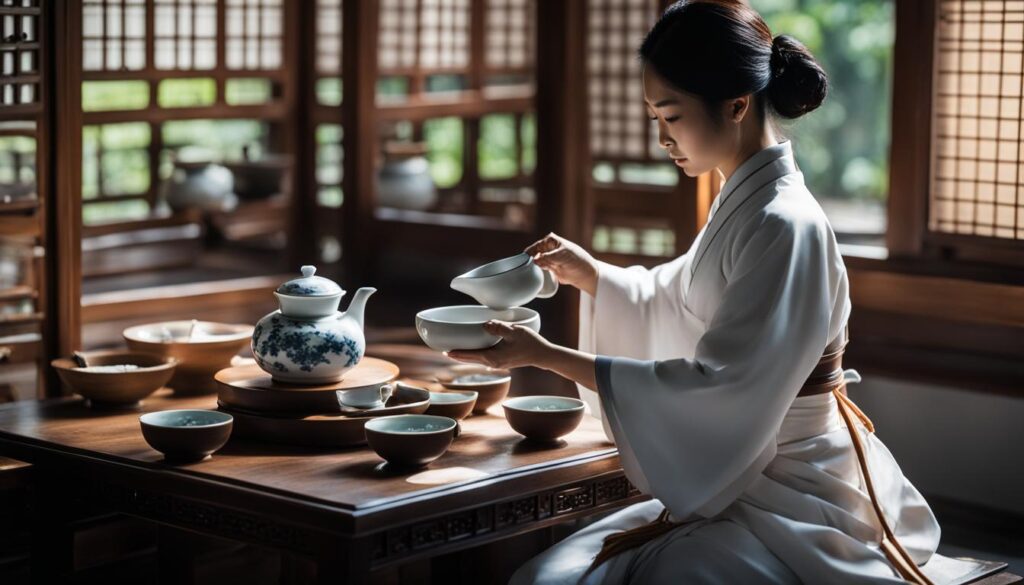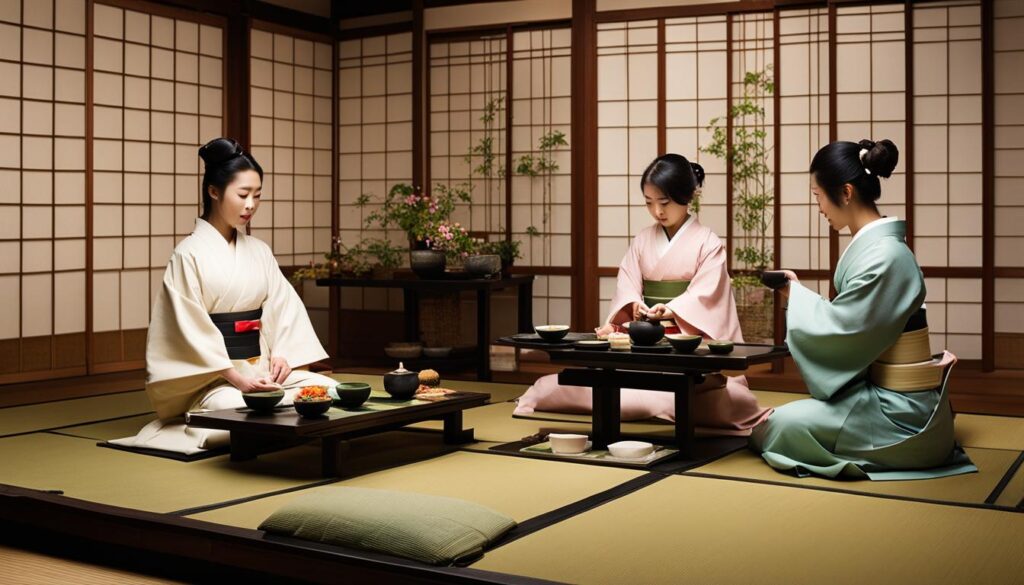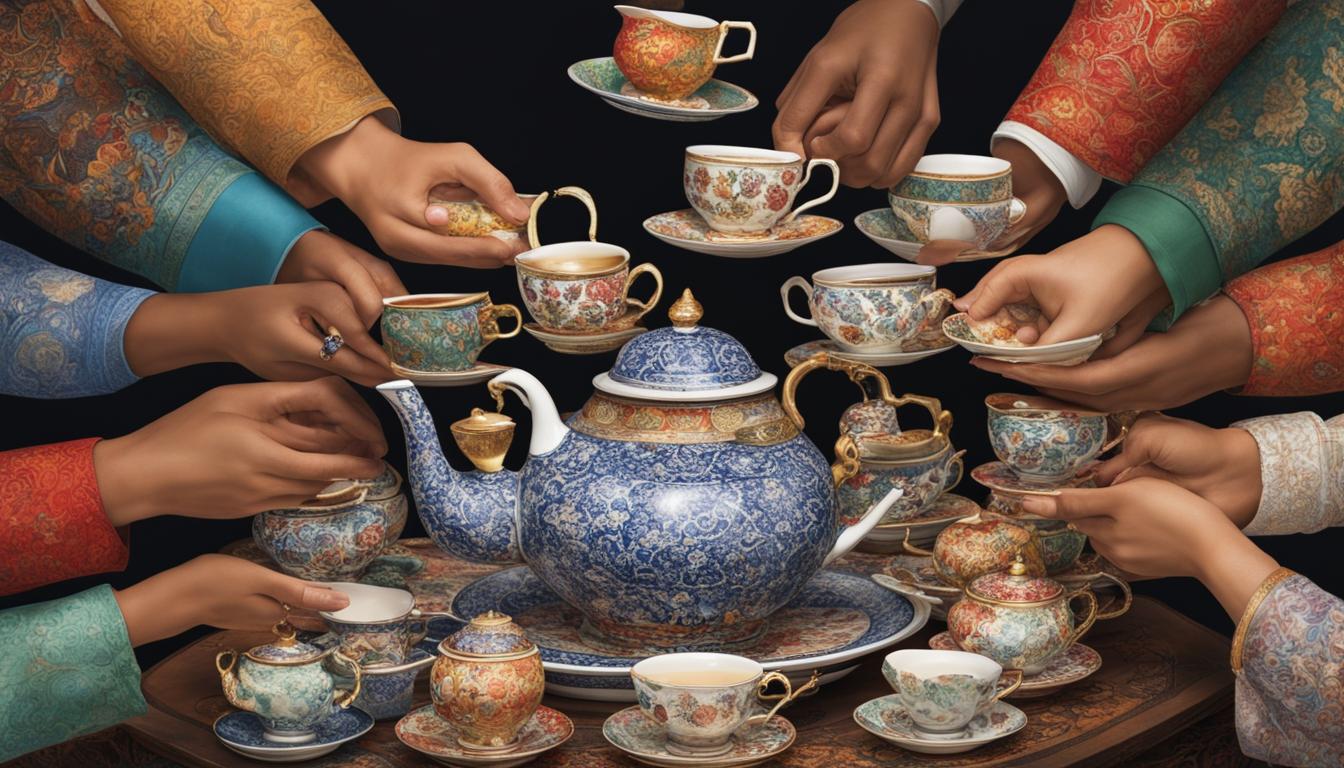Welcome to our immersive journey into the world of tea ceremonies! At Tea Lovers United, we believe that tea ceremonies offer a unique opportunity to explore diverse cultures and traditions through the lens of a single beverage. From the ancient Chinese tea rituals to the vibrant ceremonies in Japan, India, Morocco, Turkey, and Russia, tea has become a powerful symbol of mindfulness and interconnectedness.
Join us as we dive deep into the beauty of global tea ceremony appreciation and discover the mesmerizing practices that have captivated tea lovers worldwide. From the art of Chinese tea ceremony, Gongfu Cha, to the serene Japanese tea ceremony, Chanoyu, and the warm hospitality symbolized by Indian chai, we will explore tea cultures around the world.
So put the kettle on, brew your favorite tea, and prepare to embark on a journey of discovery!
Key Takeaways:
- Tea ceremonies provide a unique insight into diverse cultures and traditions.
- Tea has become a powerful symbol of mindfulness and interconnectedness.
- We will explore tea cultures from China, Japan, India, Morocco, Turkey, and Russia.
- Gongfu Cha, Chanoyu, Indian chai, Moroccan mint tea, and Turkish tea are some of the tea traditions we’ll delve into.
- Get ready to experience the beauty and richness of tea ceremony cultures from around the world!
Gongfu Cha – The Art of Chinese Tea Ceremony
Step into the world of Gongfu Cha, the artful and intricate Chinese tea ceremony that has delighted tea enthusiasts for centuries. Rooted in Daoist and Buddhist principles, Gongfu Cha is a true testament to the beauty and elegance of Chinese tea culture.
At the heart of Gongfu Cha is the meticulous preparation of high-quality loose-leaf teas, such as oolong and pu-erh. These teas, known for their complex flavors and aromas, are brewed and served in small clay teapots. It is through this delicate process that the true essence of the tea is brought to life.
The art of Gongfu Cha lies not only in the brewing of the tea but also in the appreciation of its aroma, flavor, and appearance. Each step is thoughtfully executed, from the careful selection of the tea leaves to the precise measurement of the water temperature. As the tea is poured into small cups, the distinct flavors and fragrances fill the air, creating a sensory experience that is both captivating and enchanting.
“Gongfu Cha is a celebration of patience, precision, and mindfulness. It is a true art form that allows us to connect with tea on a deeper level and appreciate its beauty in all its forms.”
Exploring the Ritual
Within the realm of Gongfu Cha, there are various rituals and practices that add to the charm of the ceremony. One such ritual is the “rinse,” where the tea leaves are briefly infused with hot water and discarded. This process is believed to awaken the flavors of the tea and cleanse the leaves.
Another aspect of Gongfu Cha is the use of traditional tea utensils, each serving a specific purpose in the brewing and serving process. From the elegant teapot to the tiny cups and bamboo tea tray, each utensil carries its own symbolism and significance, adding to the overall experience of the ceremony.
So, whether you are a tea connoisseur or simply curious about Chinese tea culture, Gongfu Cha is an art form that invites you to slow down, savor the moment, and immerse yourself in the rich traditions that have shaped the world of tea.
| Gongfu Cha Highlights | Aroma | Flavor | Appearance |
|---|---|---|---|
| Oolong Tea | Elegant and fragrant | Complex and nuanced | Vibrant color and unfurled leaves |
| Pu-erh Tea | Earthy and musky | Deep and robust | Aged and compressed |

As we delve deeper into the fascinating world of tea ceremonies, we invite you to join us on a journey that showcases the diverse practices and traditions that have shaped cultures around the world. From Gongfu Cha to Chanoyu, Chai to Moroccan Mint Tea, and Turkish Tea to Russian Tea Ceremony, each cup tells a story, offering a glimpse into the rich tapestry of global tea culture.
Chanoyu – Japan’s Serene Tea Ceremony
The Japanese tea ceremony, known as Chanoyu, is a highly choreographed form of preparing and serving matcha, a powdered green tea. Rooted in Zen Buddhism and the wabi-sabi aesthetic, Chanoyu reflects simplicity, humility, and the appreciation of imperfection. The ceremony takes place in a specially designed tearoom, creating a serene and intimate atmosphere.
During a Chanoyu, every aspect, from the preparation of the tea to the arrangement of the utensils, is carried out with meticulous attention to detail. The host meticulously selects the tea implements, ensuring they resonate with the season, theme, and atmosphere of the ceremony. Each guest awaits their turn to receive a bowl of matcha, which is prepared and whisked with precision and care.
The significance of Chanoyu lies not only in the consumption of tea but in the mindful appreciation of the entire process. From the moment guests enter the tearoom, they are encouraged to leave the outside world behind and immerse themselves fully in the present moment. The subdued lighting, sound of water boiling, and the aroma of the tea set the stage for a tranquil and meditative experience.
Kokyū – The Art of Breathing
A key element of Chanoyu is kokyū, the art of breathing. The rhythmic breathing pattern followed by both the host and guests enhances mindfulness and creates a harmonious atmosphere. The soft inhalations and exhalations help to cultivate a sense of calm and focus, allowing participants to fully engage with the tea and each other.
Omotesenke, Urasenke, and Mushanokojisenke
Chanoyu is further enriched by the various schools or “ryuha” that have preserved and passed down the art form through generations. The three main schools of Chanoyu are Omotesenke, Urasenke, and Mushanokojisenke. Each school has its unique approach to the tea ceremony, reflecting different interpretations of aesthetics, traditions, and values. While the core principles remain the same, the schools offer distinct insights into the art of Chanoyu.
| Chanoyu Schools | Characteristics |
|---|---|
| Omotesenke | Focuses on refined simplicity and elegance, emphasizing the beauty of natural materials and subtle decorations. |
| Urasenke | Places emphasis on hospitality and inclusivity, creating a warm and welcoming environment for guests. |
| Mushanokojisenke | Emphasizes the creative expression of the host, incorporating artistic elements and innovative design into the ceremony. |

“The Japanese tea ceremony invites us to slow down, be present, and find beauty in simplicity. It’s a meditative practice that brings people together through the ritual of tea. The serene atmosphere and graceful movements of Chanoyu create a sense of harmony and deepen our connection to ourselves and others.”
As we explore the rich heritage of Chanoyu, we discover the profound cultural significance of Japanese tea ceremonies. Beyond its taste and aroma, tea becomes a vessel for mindfulness, appreciation, and the embodiment of traditional values. From the art of preparation to the art of breathing, Chanoyu fosters a sense of tranquility and unity, reminding us to savor the simple joys of life.
Chai – India’s Symbol of Warmth and Hospitality
Chai, the beloved beverage of India, holds a special place in the hearts of its people. It is not merely a drink but a symbol of warmth, hospitality, and social bonding. In Indian culture, offering a cup of chai to guests is a gesture of welcome and respect, ingrained in the fabric of society.
To prepare chai, black tea leaves are simmered in a mixture of milk, water, and a blend of aromatic spices. The most common spices used include cardamom, ginger, cinnamon, and cloves, although variations exist regionally and according to personal preference. The resulting concoction is a fragrant and flavorful brew that is served piping hot, often accompanied by snacks or sweets.
The ritual of sharing chai transcends time and place. Whether it’s a morning cup enjoyed with family, a midday break with colleagues, or a late-night gathering with friends, chai is the thread that weaves people together. It brings us closer, fostering conversation, laughter, and connection. Through the simple act of sharing a warm cup of chai, we create lasting memories and forge bonds that endure.
Chai Variations Across India
Indian tea culture is vast and diverse, with each region adding its own unique twist to chai. Here are a few notable variations:
- Masala Chai: This is the quintessential Indian chai, with a robust blend of spices and a touch of sweetness.
- Adrak Chai: Ginger lovers rejoice! Adrak chai is infused with the fiery warmth of fresh ginger.
- Kadak Chai: Kadak means strong, and true to its name, this chai packs a powerful punch of flavor.
- Irani Chai: Hailing from the Irani cafes of Mumbai, this chai is brewed with a unique combination of tea leaves, milk, and sugar.
“Chai is not just a beverage; it’s a soul-soothing experience that brings people together, creating moments of joy and togetherness.” – Unknown
As we sip on a cup of chai, let us embrace the spirit of Indian tea culture – a celebration of warmth, friendship, and the art of hospitality. Let chai be our passport to the heart and soul of India, a journey of flavors and connections that transcend borders and unite us in the love for this humble, yet extraordinary, beverage.
| Region | Characteristic | Popular Spices |
|---|---|---|
| Punjab | Strong and creamy | Cardamom, cloves |
| West Bengal | Sweet and milky | Cinnamon |
| Gujarat | Sweet and spiced | Cardamom, ginger |
| Assam | Strong and malty | Cloves, cinnamon |
Moroccan Mint Tea – A Taste of Hospitality
Welcome to the enchanting world of Moroccan mint tea, where tradition meets hospitality. This cherished beverage, also known as Maghrebi mint tea, is more than just a drink; it is a symbol of warmth, friendship, and Moroccan culture. The preparation and sharing of Moroccan mint tea is deeply ingrained in the fabric of Moroccan society, fostering a sense of camaraderie and connection.
In Moroccan tea traditions, the art of pouring mint tea is an act of grace, skill, and pride. Tea is poured from a teapot with a long spout held high above small glasses, creating a beautiful, cascading stream that aerates the tea and enhances its flavor. The tea is traditionally served three times, each pour with its own distinct flavor, from bitter to sweet, symbolizing life’s progression from bitterness to sweetness.
The unique blend of green tea, fresh mint leaves, and sugar creates a refreshing and aromatic beverage that is enjoyed throughout the day in Morocco. The combination of the mint’s coolness and the tea’s warmth provides a balance that is both soothing and invigorating. Whether sipped in the bustling streets of Marrakech or the tranquil courtyards of Fez, Moroccan mint tea embodies the country’s rich hospitality and invites you to immerse yourself in its vibrant culture.
Turkish Tea – A Symbol of Turkish Hospitality
Turkish tea, also known as Çay, holds a special place in Turkish culture, serving as a symbol of hospitality and a vessel for social connection. The traditional Turkish tea ceremony is an integral part of daily life, offering a warm invitation for friends, family, and even strangers to gather and share heartfelt conversations.
When enjoying Turkish tea, it is customary to use small tulip-shaped glasses called “fincan” and a two-tiered teapot known as a “çaydanlık.” The lower kettle holds boiling water, while the upper kettle brews the concentrated tea. The tea is served in the glass, diluted with hot water according to personal preference.
“A cup of Turkish tea is like a thousand words.” This popular Turkish saying reflects the significance of tea in facilitating meaningful connections. Whether it’s a lively discussion with friends at a local teahouse or a heartfelt chat with neighbors in a Turkish home, the act of sharing tea fosters a sense of unity, warmth, and genuine hospitality.
So, let’s pay homage to the Turkish tea culture and celebrate its role in connecting people, bridging gaps, and promoting friendship. As we indulge in a cup of fragrant Turkish tea, let’s remember that it is more than just a beverage. It is a vessel for building everlasting bonds and embracing the welcoming spirit of Turkey.
| Aspect | Details |
|---|---|
| Tea Name | Turkish Tea (Çay) |
| Main Ingredients | Black tea leaves |
| Preparation | Brewed in a two-tiered teapot and served in small tulip-shaped glasses |
| Symbolism | Hospitality, social connection, and unity |
Conclusion
Tea ceremonies have captivated cultures around the world, offering a glimpse into diverse histories, traditions, and cultural exchange. From China to Japan, India to Morocco, Turkey to Russia, the appreciation of tea rituals has transcended borders, uniting people through a shared love for tea. As we embrace the global appreciation of traditional tea ceremonies, we celebrate the beauty, mindfulness, and richness of tea culture from every corner of the globe.
Throughout our journey, we have explored the artistry and significance behind Gongfu Cha, the Chinese tea ceremony, where the focus lies on the art of preparation and the sensory experience of the tea. We’ve delved into the serene realm of Chanoyu, the Japanese tea ceremony, rooted in Zen Buddhism and characterized by simplicity and humility. We’ve experienced the warmth and hospitality of India through Chai, a symbol of social bonding and a gesture of welcome. We’ve savored the camaraderie and community fostered by Moroccan Mint Tea, a cherished tradition that brings people together. And we’ve witnessed the integral role of Turkish Tea in Turkish daily life, exemplifying their culture of hospitality.
These tea ceremonies, each unique in its own way, offer us a deeper understanding of tea as more than just a beverage. They are expressions of cultural identity, traditions passed down through generations, and gestures of respect and conviviality. As we sip our teas across continents, we are reminded of the timeless connections we share through this ancient and revered beverage. So let us raise our cups in appreciation, to the global tea ceremony traditions that continue to enrich our lives and bring us together.
FAQ
What is a tea ceremony?
A tea ceremony is a ritualized way of preparing and serving tea that varies across different cultures and traditions. It often involves specific techniques, tools, and etiquette to enhance the experience of enjoying tea.
Why are tea ceremonies important?
Tea ceremonies offer an opportunity to appreciate the beauty of tea, explore cultural traditions, and promote mindfulness and interconnectedness. They provide a glimpse into diverse histories and promote a sense of unity among tea lovers worldwide.
What is Gongfu Cha?
Gongfu Cha is the Chinese tea ceremony that emphasizes the art of tea preparation and the appreciation of its aroma, flavor, and appearance. It is rooted in Daoist and Buddhist principles and often uses high-quality loose-leaf teas.
What is Chanoyu?
Chanoyu is the Japanese tea ceremony that involves the highly choreographed preparation and serving of matcha, a powdered green tea. It reflects simplicity, humility, and the appreciation of imperfection.
What is Chai?
Chai is a popular beverage in India, made by boiling black tea leaves with a mixture of milk, water, and spices. It symbolizes warmth, hospitality, and social bonding in Indian culture.
What is Moroccan Mint Tea?
Moroccan Mint Tea, also known as Maghrebi mint tea, is a traditional beverage in Morocco. It is poured from a teapot with a long spout held high above small glasses, creating an aerating and mixing effect. Sharing mint tea is a symbol of camaraderie in Moroccan culture.
What is Turkish Tea?
Turkish Tea, known as Çay, is a strong black tea brewed in a two-tiered teapot. It is served in small tulip-shaped glasses and is an integral part of daily life and social customs in Turkey, representing Turkish hospitality.





